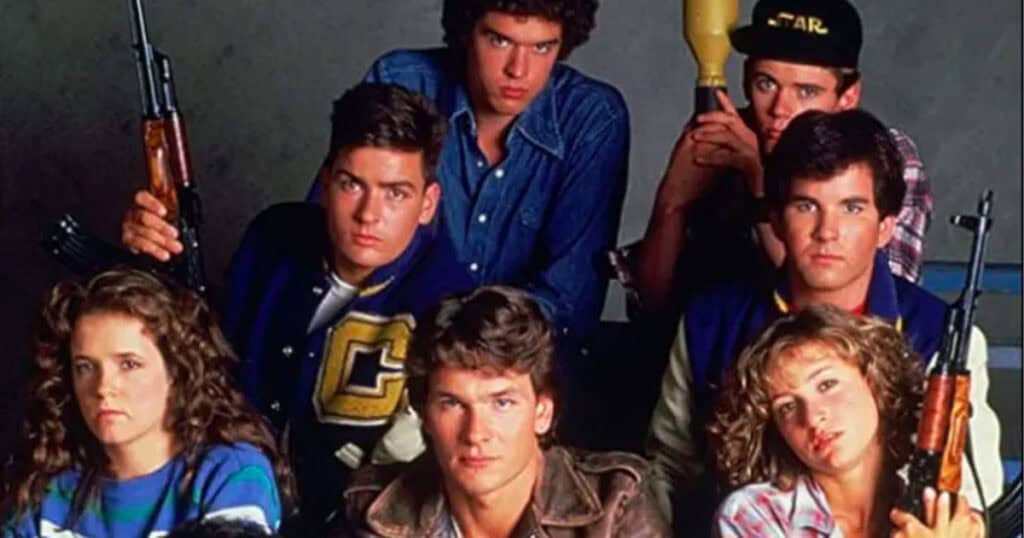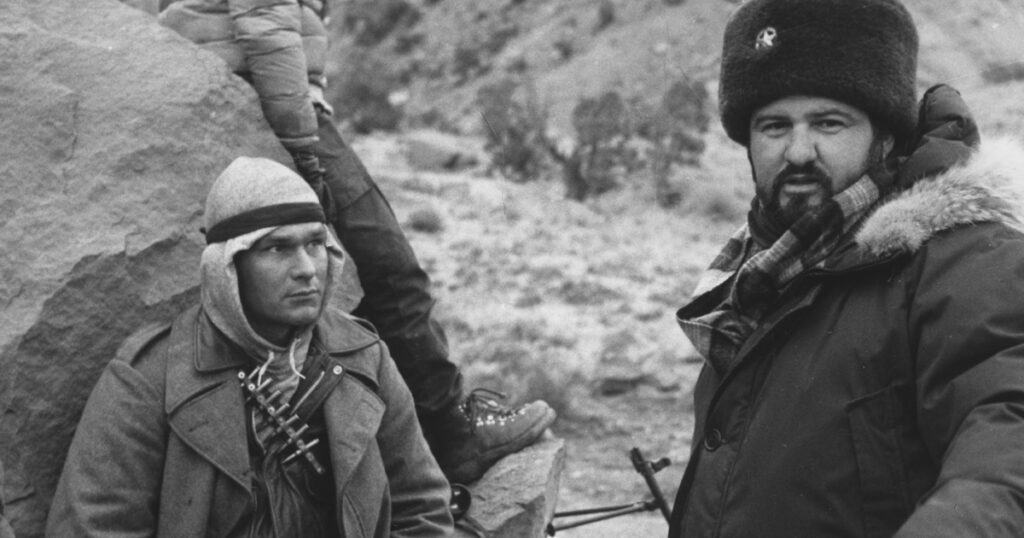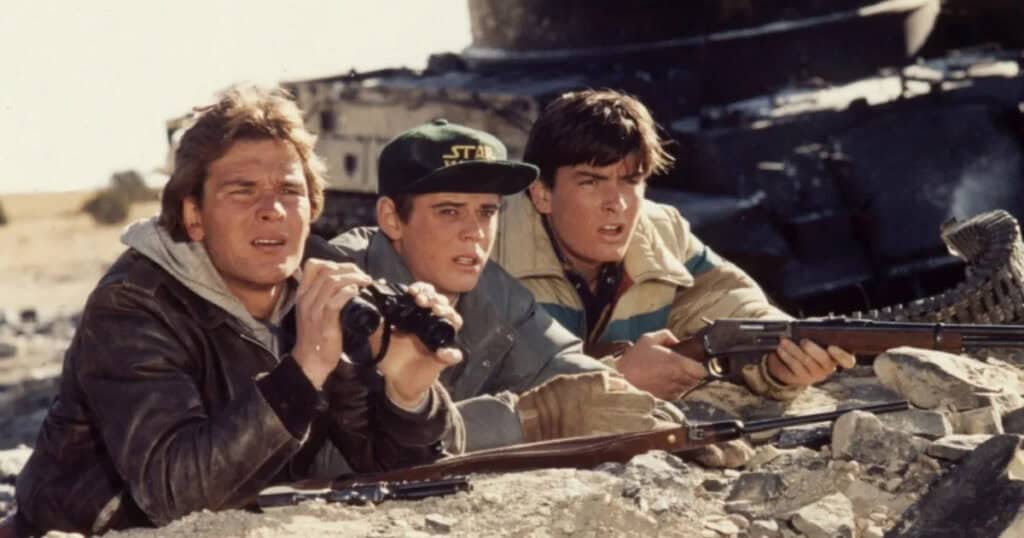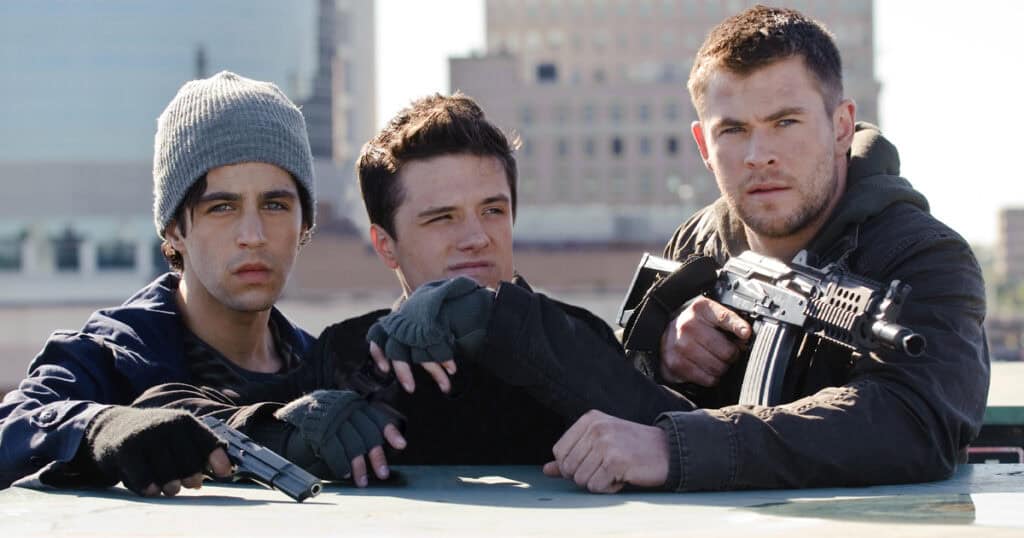
The early 80s were a tumultuous period for much of the world. Tensions were high as the Second Cold War continued to play out between the U.S. and the Soviet Union; the ramifications of what would happen if the two nations fell out would be felt across the globe. America had elected Ronald Reagan to the Oval Office, and his passionate rhetoric about the Soviets did little to calm concerns about a possible third World War – which, thanks to nuclear weaponry, wouldn’t be as much a war as a worldwide holocaust. So yeah, it was a bit of a nerve-jangling time to be alive, but thankfully we still had the movies to chill us out.
While Hollywood was still dealing with the fallout from Vietnam with pictures as diverse as The Deer Hunter, Coming Home and First Blood, they were about to start making movies about the New Cold War and the immense fear that we weren’t far from ultimate destruction. Perhaps no movie better represents that fraught time than Red Dawn, the sombre 1984 action-drama that sees a small group of high school kids attempt to defend their small town from an invasion led by a coalition of Soviets and Cubans. While some hailed it as a grimly realistic look at local warfare, others scorned it for being a right-wing fever dream. Whichever side of the fence you stand on, get your gear and prepare for battle because we’re going to find out What Happened to Red Dawn.
Why Was It Written?
Red Dawn began life as a spec script written by USC student Kevin Reynolds, who years later would be best known as the director of the big budget Kevin Costner films Robin Hood: Prince of Thieves and Waterworld. A young protege of Steven Spielberg, Reynolds wrote the script Ten Soldiers as a way to imagine what it would look like if war actually broke out in our own backyard, as the writer put it. And as the Cold War was going strong at the time, the idea of Soviets storming our beaches didn’t seem too far-fetched… More of a character drama in the vein of Lord of the Flies about the impact of battle on a group of students, the script began to make the rounds in Hollywood, attracting interest from a number of studios. Eventually, it landed at MGM, whose big boss, Frank Yablans, saw an opportunity to make a film that was closer to an action-heavy war film than the thoughtful anti-war character study that was Reynolds’ original vision. MGM was looking for a hit, and Ten Soldiers could appeal to the millions of U.S. citizens who voted for Ronald Reagan and wanted nothing more than to see Russians defeated by scrappy Americans.
While Reynolds had hoped to direct the film, it was clear that the studio was not on the same page as he was in terms of Ten Soldiers, and he ultimately received story and co-writing credit, but no shot at directing. The director Frank Yablans had in mind was a gung-ho, gun-loving writer-director named John Milius, at the time known for tough, testosterone-heavy scripts like Magnum Force and Apocalypse Now, as well as directing the Arnold Schwarzenegger epic Conan the Barbarian. Milius was that rare thing in Hollywood – a Conservative, albeit one well-liked by liberals – and it seemed only logical that he’d be the man to transform the anti-war Ten Soldiers into something closer to First Blood.

John Millus and Alexander Haig
Milius would have an unusual collaborator on the film, which was now titled Red Dawn in an effort to sound more ominous. Alexander Haig was a former chief of staff to Presidents Nixon and Ford and more recently the secretary of state to President Reagan. Having left politics behind, Haig was now a member of MGM’s board of directors and something like Red Dawn was right up his alley. Haig was even further to the right politically than Milius, who found Haig’s suggestions slightly alarming, and while he was certainly more conservative than liberal, Milius’ wondered if the project was slipping into something more pro-war than even he was envisioning. Word then was that the Pentagon was even advising Milius on how to stage the invasion and combat sequences, and some in Hollywood worried that the finished film was going to be used as a recruiting film for the younger generation. Even though the movie eventually took a beating for its alleged pro-war leanings, Milius would always maintain he set out to make an anti-war film; a movie which showed the futility of war… But that comes later.
Whatever influence Haig had on the Red Dawn screenplay, it was now most certainly a different animal than Ten Soldiers, and thanks to a bevy of newly inserted action sequences, it was going to be more expensive and the budget eventually hovered around $17 million. A bevy of vehicles meant to represent Soviet tanks and trucks were made, some of them so convincing that one day the C.I.A. snooped around the production wondering where they had acquired the neatly-outfitted weapons of war.

A Hot Cast
What wouldn’t be expensive was the cast, as it was to be made up of young up-and-comers and a handful of veteran character actors. While the majority of the young cast would have to audition, the lead role of Jed was offered to Patrick Swayze, then hot off his breakout role in The Outsiders. Patrick had just lost his beloved father, and the pain he felt from that loss was brought into every scene in Red Dawn according to some of his co-stars. He also became the de facto leader of the young group; John Milius was known on the set as “the general,” and Swayze “the lieutenant.” The director would even give Swayze directions for the youngsters, wanting them to get their marching orders from the older actor in an effort to solidify his position as the guy they looked up to.
Swayze’s Outsiders co-star C. Thomas Howell was cast as the disturbed Robert in the film. Because Howell actually grew up riding horses and was on the verge of becoming a rodeo star, he was the one everyone else looked to for advice on how to ride.
This was a big film for a young Charlie Sheen; in fact, it was his first major role. He’d gotten the script for it from his good friend Chris Penn. Sheen is of course the son of actor Martin Sheen, and had even been on the set of Apocalypse Now as a teenager; that movie of course also co-written by John Milius. Now, here he was, playing war for Milius just like his father had five years prior.
Our group has two female soldiers, both played by soon-to-be-famous young actresses Lea Thompson and Jennifer Grey. Milius would audition his actresses by asking them some simple but blunt questions: Could you ride a horse? Could you kill and eat an animal if you had to? Any of the girls who answered in the affirmative obviously went to the top of the pile.
Evidently, Jennifer Grey and Patrick Swayze did not get along at all on the set. Some tension existed between them that was palpable to the other cast members. As fate would have it, the two would come together once more a handful of years later in the hit Dirty Dancing.
As the film’s two villains, a Russian special forces commander and a Cuban colonel, Milius cast American actors William Smith and Ron O’Neal, respectively. O’Neal was then best known as the one and only Superfly, though he was also a celebrated stage actor. Smith, on the other hand, had a very indirect path to the casting sheet: he was once an intelligence expert for the United States Air Force during the Korean War and was fluent in five languages, including Russian. A well-regarded character actor known for playing bad guys – as well as Conan the Barbarian’s father – Smith evidently stayed in character while on set, and no one wanted to go near him because of how intimidating he was while he barked orders in perfect Russian.
Novice actor Brad Savage took a unique approach to getting hired for the role. One day, after he’d already auditioned, he went to John Milius’ office and hurled a grenade under the director’s desk in an abrupt display. Obviously, the grenade was fake, but the stones it took for Savage to attempt the prank impressed Milius, who admired the unconventional.
So unconventional was Milius that he always carried a gun on him; to meetings, to lunch, on set, wherever. Apparently the gun was always filled with blanks, and sometimes if he was feeling a bit anxious or displeased Milius calmed himself down by firing the gun a few times. Next time you watch The Big Lebowski remember that the character of Walter was partially modeled after Milius; you’ll get a vague idea of what the man was like.

John Millius
Weeks before filming was to commence in New Mexico, Milius put his young ensemble through the rigors of boot camp. Two former Green Berets would take the kids out into the woods and put them through the ringer, even hunting them for sport in order to toughen them up and put them in the heat of guerrilla warfare. Dale Dye, the infamous consultant on many of Hollywood’s most notable war movies, would drive the cast hard, making them run for miles without giving them breakfast until they were completely worn down. The cast also had to complete weapons training too, firing all manner of machine guns, handguns, rifles and whatever else was available. Milius eventually let each actor pick their weapon of choice for their character to carry for the duration of the film.
In order to get Russian speaking soldiers suited up, the casting department had an inspired idea: they went to nearby University of New Mexico, which just happens to have one of the preeminent Russian studies departments in the country. This is where they found the majority of their young Russian soldiers.
Shooting took place in and around the very small town of Las Vegas, New Mexico, from October 1983 to January 1984. The longer they shot, the colder it got, and the finale sequence that takes place during a snow storm was literally freezing, about 40 degrees below zero with the wind chill. Patrick Swayze and a few others reportedly got frostbite from the frigid conditions. The town itself often found itself rocked by controlled explosions used by the production, some of which were so powerful that windows were being blasted out and trailers were being knocked over.
One frightening incident occurred during the film’s eerie opening sequence that sees the foreign invaders landing via parachute onto the lawn of a high school. While shooting this sequence using trained parachutists, several of the participants got blown off course by about a mile, some of them getting injured in trees and even barbed wire. Part of the reason for this mishap was the high winds swirling around the plane as well as a target landing area that was deemed too small. It was eventually found that the producers did not acquire the necessary permits from the FAA to film a jump taking place over a populated area, and this led to new safety guidelines being created for any production using a parachuter.

The First PG-13?
Frostbite and freak parachute accidents aside, Red Dawn reportedly finished shooting under budget and on schedule. The film was given an August 10th release date by MGM. In July, it was announced Red Dawn would be the first film to be released with a PG-13 rating after the controversy surrounding the violence in that same summer’s Indiana Jones and the Temple of Doom and Gremlins. It was Steven Spielberg himself who suggested the MPAA create a rating between PG and R, and Red Dawn would have the honor of being the first movie out of the gate with that distinction.
The film was met with ample controversy, resulting in protests from left-leaning citizens who thought it was pro-war propaganda meant to drum up paranoia. Word was that Ronal Reagan loved it, while it was predictably lambasted in the Soviet Union.
One interesting badge of honor, depending on who you ask, was that the National Coalition on Television Violence labeled Red Dawn the most violent film ever at the time, having recorded 134 acts of violence per hour. The Guinness Book of World Records came to a similar finding. Whether or not this helped or hurt it at the box office is up for debate. The film had a domestic take of $38 million when all was said and done, perhaps making a minor profit considering its $17 million budget.
But Red Dawn has stayed in the conversation since its release, the arguments about it being vehemently pro-war or anti-war still rage on. And its cultural impact is even bigger than you might realize: when U.S. forces captured Saddam Hussein in 2003, that operation was codenamed Red Dawn, a fact John Milius reportedly loved.

A Terrible Remake
In 2010, Red Dawn found itself getting the remake treatment, although this time the enemy invaders were Chinese. Milius was given an opportunity to read the script beforehand and trashed it, saying it was “terrible” and the idea of remaking it in general was a “stupid thing to do.” The movie was shelved for two years thanks to MGM’s financial troubles, and once it was released the villains had magically gone from Chinese to North Korean in a cynical and insulting effort to make money from China’s lucrative film market and not jeopardize potential future co-productions… The joke was on the studio, however, as the Red Dawn remake was never released in China anyway.
Red Dawn is seen by some as a relic from a different era; others hail it as a testament to what Milius called the futility of war. Milius feared the movie would get him blacklisted in Hollywood, and it just may have, though he still worked on plenty of notable projects throughout the years, including the HBO series Rome, which he helped create. For better or worse, Red Dawn is one of the primary movies he’ll always be remembered for. He’d probably have it no other way.
The post What Happened to Red Dawn (1984)? appeared first on JoBlo.
Leave a Reply